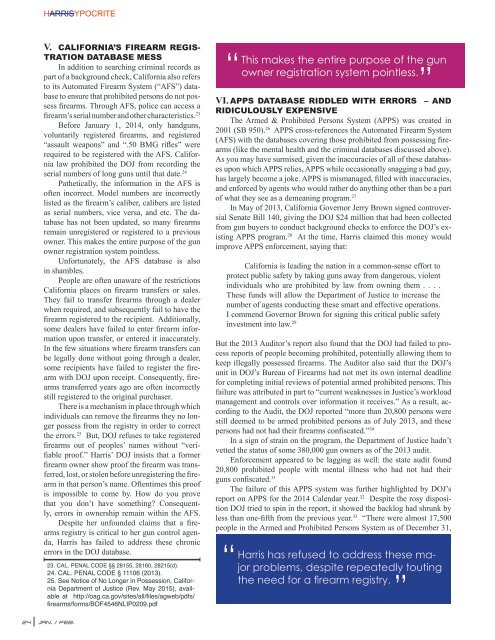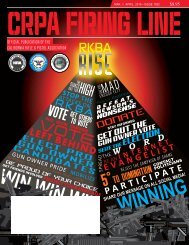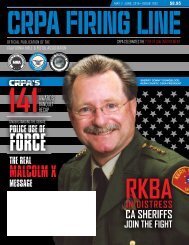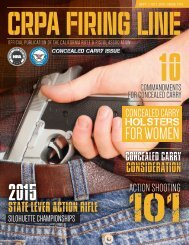CRPA Jan-Feb 2016
You also want an ePaper? Increase the reach of your titles
YUMPU automatically turns print PDFs into web optimized ePapers that Google loves.
HARRISYPOCRITE<br />
V. CALIFORNIA’S FIREARM REGIS-<br />
TRATION DATABASE MESS<br />
In addition to searching criminal records as<br />
part of a background check, California also refers<br />
to its Automated Firearm System (“AFS”) database<br />
to ensure that prohibited persons do not possess<br />
firearms. Through AFS, police can access a<br />
firearm’s serial number and other characteristics. 23<br />
Before <strong>Jan</strong>uary 1, 2014, only handguns,<br />
voluntarily registered firearms, and registered<br />
“assault weapons” and “.50 BMG rifles” were<br />
required to be registered with the AFS. California<br />
law prohibited the DOJ from recording the<br />
serial numbers of long guns until that date. 24<br />
Pathetically, the information in the AFS is<br />
often incorrect. Model numbers are incorrectly<br />
listed as the firearm’s caliber, calibers are listed<br />
as serial numbers, vice versa, and etc. The database<br />
has not been updated, so many firearms<br />
remain unregistered or registered to a previous<br />
owner. This makes the entire purpose of the gun<br />
owner registration system pointless.<br />
Unfortunately, the AFS database is also<br />
in shambles.<br />
People are often unaware of the restrictions<br />
California places on firearm transfers or sales.<br />
They fail to transfer firearms through a dealer<br />
when required, and subsequently fail to have the<br />
firearm registered to the recipient. Additionally,<br />
some dealers have failed to enter firearm information<br />
upon transfer, or entered it inaccurately.<br />
In the few situations where firearm transfers can<br />
be legally done without going through a dealer,<br />
some recipients have failed to register the firearm<br />
with DOJ upon receipt. Consequently, firearms<br />
transferred years ago are often incorrectly<br />
still registered to the original purchaser.<br />
There is a mechanism in place through which<br />
individuals can remove the firearms they no longer<br />
possess from the registry in order to correct<br />
the errors. 25 But, DOJ refuses to take registered<br />
firearms out of peoples’ names without “verifiable<br />
proof.” Harris’ DOJ insists that a former<br />
firearm owner show proof the firearm was transferred,<br />
lost, or stolen before unregistering the firearm<br />
in that person’s name. Oftentimes this proof<br />
is impossible to come by. How do you prove<br />
that you don’t have something? Consequently,<br />
errors in ownership remain within the AFS.<br />
Despite her unfounded claims that a firearms<br />
registry is critical to her gun control agenda,<br />
Harris has failed to address these chronic<br />
errors in the DOJ database.<br />
23. CAL. PENAL CODE §§ 28155, 28160, 28215(d).<br />
24. CAL. PENAL CODE § 11106 (2013).<br />
25. See Notice of No Longer in Possession, California<br />
Department of Justice (Rev. May 2015), available<br />
at http://oag.ca.gov/sites/all/files/agweb/pdfs/<br />
firearms/forms/BOF4546NLIP0209.pdf<br />
“<br />
This makes the entire purpose of the gun<br />
owner registration system pointless.<br />
”<br />
VI. APPS DATABASE RIDDLED WITH ERRORS – AND<br />
RIDICULOUSLY EXPENSIVE<br />
The Armed & Prohibited Persons System (APPS) was created in<br />
2001 (SB 950). 26 APPS cross-references the Automated Firearm System<br />
(AFS) with the databases covering those prohibited from possessing firearms<br />
(like the mental health and the criminal databases discussed above).<br />
As you may have surmised, given the inaccuracies of all of these databases<br />
upon which APPS relies, APPS while occasionally snagging a bad guy,<br />
has largely become a joke. APPS is mismanaged, filled with inaccuracies,<br />
and enforced by agents who would rather do anything other than be a part<br />
of what they see as a demeaning program. 27<br />
In May of 2013, California Governor Jerry Brown signed controversial<br />
Senate Bill 140, giving the DOJ $24 million that had been collected<br />
from gun buyers to conduct background checks to enforce the DOJ’s existing<br />
APPS program. 28 At the time, Harris claimed this money would<br />
improve APPS enforcement, saying that:<br />
California is leading the nation in a common-sense effort to<br />
protect public safety by taking guns away from dangerous, violent<br />
individuals who are prohibited by law from owning them . . . .<br />
These funds will allow the Department of Justice to increase the<br />
number of agents conducting these smart and effective operations.<br />
I commend Governor Brown for signing this critical public safety<br />
investment into law. 29<br />
But the 2013 Auditor’s report also found that the DOJ had failed to process<br />
reports of people becoming prohibited, potentially allowing them to<br />
keep illegally possessed firearms. The Auditor also said that the DOJ’s<br />
unit in DOJ’s Bureau of Firearms had not met its own internal deadline<br />
for completing initial reviews of potential armed prohibited persons. This<br />
failure was attributed in part to “current weaknesses in Justice’s workload<br />
management and controls over information it receives.” As a result, according<br />
to the Audit, the DOJ reported “more than 20,800 persons were<br />
still deemed to be armed prohibited persons as of July 2013, and these<br />
persons had not had their firearms confiscated.” 30<br />
In a sign of strain on the program, the Department of Justice hadn’t<br />
vetted the status of some 380,000 gun owners as of the 2013 audit.<br />
Enforcement appeared to be lagging as well: the state audit found<br />
20,800 prohibited people with mental illness who had not had their<br />
guns confiscated. 31<br />
The failure of this APPS system was further highlighted by DOJ’s<br />
report on APPS for the 2014 Calendar year. 32 Despite the rosy disposition<br />
DOJ tried to spin in the report, it showed the backlog had shrunk by<br />
less than one-fifth from the previous year. 33 “There were almost 17,500<br />
people in the Armed and Prohibited Persons System as of December 31,<br />
“<br />
Harris has refused to address these major<br />
problems, despite repeatedly touting<br />
the need for a firearm registry.<br />
”<br />
24<br />
JAN. / FEB.








